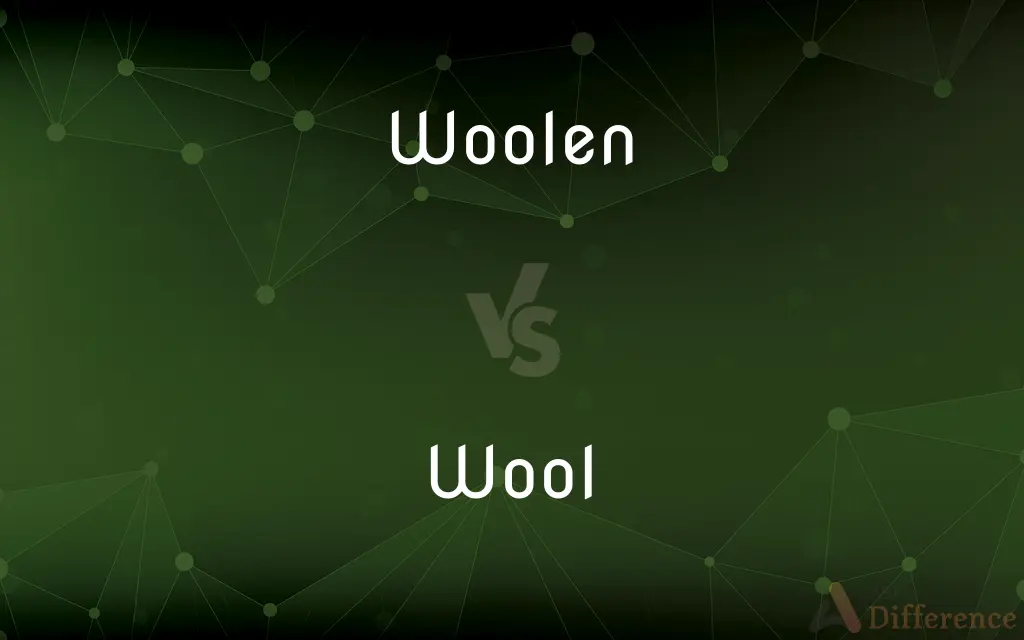Woolen vs. Wool — What's the Difference?
By Maham Liaqat & Fiza Rafique — Updated on March 27, 2024
Woolen refers to yarn made from carded wool, used for warm, fluffy fabrics, while wool is the soft, curly fibers from sheep or other animals, used in textiles.

Difference Between Woolen and Wool
Table of Contents
ADVERTISEMENT
Key Differences
Woolen yarns are characterized by their bulky, soft texture, which is achieved through a carding process that aligns the fibers in a somewhat disorganized manner. This process makes woolen fabrics especially warm and insulating. On the other hand, wool refers to the raw fibers harvested from animals such as sheep, goats, and alpacas. These fibers are versatile and can be processed in various ways, including being spun into woolen or worsted yarns.
Woolen fabrics are often used for cozy, winter garments like sweaters and blankets due to their excellent heat retention. Whereas wool, in its broader application, is utilized not only for clothing but also for finer textiles, carpets, and upholstery, showcasing its adaptability in both heavy-duty and delicate fabrics.
The manufacturing process for woolen yarn involves carding, which produces a loftier yarn with shorter fibers, leading to a fabric that is softer and fuzzier. This contrasts with wool processing for worsted yarns, which involves combing the fibers to align them, resulting in smoother and stronger yarns. Wool, therefore, encompasses a wider range of fabric types and textures depending on its processing.
Woolen garments are typically more prone to pilling and wear due to the shorter fibers and looser spin. Wool, depending on its treatment and the specific yarn type, can be more durable and resistant to pilling, especially in its worsted form. This makes woolen items require more gentle care compared to some wool garments.
The environmental impact of woolen and wool products can vary based on the source of the wool and the manufacturing process. Woolen items, being thicker and often requiring less chemical processing than finer wools, might be considered more sustainable. However, all wool products share the advantage of being natural, renewable, and biodegradable, highlighting wool's overall eco-friendly attributes.
ADVERTISEMENT
Comparison Chart
Definition
Yarn made from carded wool, for fluffy fabrics
Soft, curly fibers from animals, for textiles
Texture
Bulky and soft
Can vary from soft and fluffy to smooth and fine
Usage
Cozy garments like sweaters, blankets
Wide range including clothing, carpets, upholstery
Manufacturing
Carding process aligns fibers disorganizedly
Can involve carding or combing, depending on the yarn type
Durability
More prone to pilling and wear
Can be more durable, especially in worsted form
Compare with Definitions
Woolen
Characterized by a fluffy texture.
The woolen blanket was incredibly soft against the skin.
Wool
Material used in the production of textiles.
The wool coat was both stylish and durable.
Woolen
Used for making insulating clothing.
He preferred woolen socks for their superior warmth.
Wool
A symbol of warmth and comfort.
They donated wool blankets to the shelter for added warmth.
Woolen
Made from carded wool, producing a soft and bulky yarn.
The woolen sweater was perfect for cold winter nights.
Wool
Versatile in its applications.
Wool can be used for everything from sweaters to durable carpets.
Woolen
Relating to the woolen textile industry.
The woolen mills were an essential part of the town's economy.
Wool
Eco-friendly and sustainable.
Choosing wool products supports sustainable fashion practices.
Woolen
Pertaining to woolen fabrics or garments.
Her collection of woolen scarves was both colorful and warm.
Wool
Soft, curly fibers obtained from sheep and other animals.
She spun the wool into a fine yarn.
Woolen
Woolen (American English) or woollen (Commonwealth English) is a type of yarn made from carded wool. Woolen yarn is soft, light, stretchy, and full of air.
Wool
Wool is the textile fibre obtained from sheep and other animals, including cashmere and mohair from goats, qiviut from muskoxen, hide and fur clothing from bison, angora from rabbits, and other types of wool from camelids.Wool consists of protein together with a small percentage of lipids. In this regard it is chemically quite distinct from the more dominant textile, cotton, which is mainly cellulose.
Woolen
Made or consisting of wool.
Wool
The fine, soft curly or wavy hair forming the coat of a sheep, goat, or similar animal, especially when shorn and prepared for use in making cloth or yarn
Harris tweed is made from pure new wool
Woolen
Of or relating to the production or marketing of woolen goods.
Wool
The dense, soft, often curly hair forming the coat of sheep and certain other mammals, such as the goat and alpaca, consisting of cylindrical strands of keratin covered by minute overlapping scales and much valued as a textile fiber.
Woolen
Fabric or clothing made from wool.
Wool
Fabric or yarn made of this hair.
Woolen
Made of wool.
Wool
Hairy or downy material on a plant or animal, as on certain caterpillars.
Woolen
Of or relating to wool or woolen cloths.
Woolen manufactures
A woolen mill
A woolen draper
Wool
Filamentous or fibrous material similar to the wool of a sheep or other mammal.
Woolen
(American spelling) An item of clothing made from wool
Put all the woolens in this basket.
Wool
The hair of the sheep, llama and some other ruminants.
Woolen
Made of wool; consisting of wool; as, woolen goods.
Wool
A cloth or yarn made from the wool of sheep.
Woolen
Of or pertaining to wool or woolen cloths; as, woolen manufactures; a woolen mill; a woolen draper.
Wool
Anything with a texture like that of wool.
Woolen
Cloth made of wool; woollen goods.
Wool
A fine fiber obtained from the leaves of certain trees, such as firs and pines.
Woolen
A fabric made from the hair of sheep
Wool
(obsolete) Short, thick hair, especially when crisped or curled.
Woolen
Of or related to or made of wool;
A woolen sweater
Wool
Yarn, including that made from synthetic fibers.
Wool
A resident of a satellite town outside Liverpool, such as St Helens or Warrington. See also Yonner.
Wool
The soft and curled, or crisped, species of hair which grows on sheep and some other animals, and which in fineness sometimes approaches to fur; - chiefly applied to the fleecy coat of the sheep, which constitutes a most essential material of clothing in all cold and temperate climates.
Wool
Short, thick hair, especially when crisped or curled.
Wool of bat and tongue of dog.
Wool
A sort of pubescence, or a clothing of dense, curling hairs on the surface of certain plants.
Wool
A fabric made from the hair of sheep
Wool
Fiber sheared from animals (such as sheep) and twisted into yarn for weaving
Wool
Outer coat of especially sheep and yaks
Common Curiosities
What is wool used for?
Wool is used for a wide range of products, including clothing, blankets, carpets, and upholstery, thanks to its versatility and warmth.
Is woolen warmer than wool?
Woolen fabrics, due to their loft and bulk, are generally warmer and better insulators than some tightly woven wool fabrics.
How is woolen yarn made?
Woolen yarn is made through a carding process that disorganizes the fibers, creating a loftier and softer yarn.
What is woolen fabric?
Woolen fabric is a textile made from woolen yarn, characterized by its soft, fluffy texture and excellent insulation properties.
How does woolen compare to worsted wool?
Woolen yarns are bulkier and softer due to the carding process, while worsted wool yarns are smoother and stronger, made by combing the fibers.
Is all wool scratchy?
No, the scratchiness of wool depends on the type of wool and how it's processed; some wool, like Merino, is very soft.
Can wool be dyed?
Yes, wool can be dyed in a variety of colors, and it holds dye well due to its natural properties.
How should woolen garments be cared for?
Woolen garments should be cared for gently, often requiring hand washing or specific cleaning instructions to avoid damage.
Are woolen fabrics good for the environment?
Woolen fabrics, like all wool products, are considered good for the environment due to their natural, renewable, and biodegradable nature.
Why do woolen garments pill?
Woolen garments tend to pill due to the shorter fibers and looser spin, which allows fibers to work loose and form balls.
What makes woolen different from other wool products?
Woolen refers specifically to products made from carded wool yarn, which is softer and bulkier than worsted wool products.
Can wool be eco-friendly?
Yes, wool is a natural, renewable, and biodegradable resource, making it an eco-friendly choice for textiles.
Why is wool popular for winter clothing?
Wool's insulating properties and ability to retain warmth even when wet make it popular for winter clothing and accessories.
What is the difference in texture between woolen and wool?
Woolen yarns and fabrics have a bulkier, softer texture, while wool can vary from soft and fluffy to smooth and fine, depending on the processing.
What animals provide wool?
Sheep are the primary source of wool, but goats (cashmere and mohair), alpacas, and rabbits (angora) also provide wool.
Share Your Discovery

Previous Comparison
Bossy vs. Control
Next Comparison
Befuddled vs. BewilderedAuthor Spotlight
Written by
Maham LiaqatCo-written by
Fiza RafiqueFiza Rafique is a skilled content writer at AskDifference.com, where she meticulously refines and enhances written pieces. Drawing from her vast editorial expertise, Fiza ensures clarity, accuracy, and precision in every article. Passionate about language, she continually seeks to elevate the quality of content for readers worldwide.














































